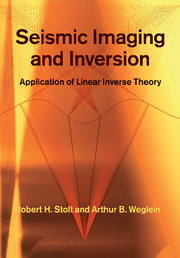Book contents
- Frontmatter
- Contents
- Preface and acknowledgments
- 1 Introduction – modeling, migration, imaging, and inversion
- 2 Basic migration concepts
- 3 Prestack migration
- 4 Migration limitations
- 5 Models for wave propagation and reflection
- 6 Green's functions
- 7 The scattering potential
- 8 Reflectivity
- 9 Synthesizing reflection data
- 10 Frequency–wavenumber migration
- 11 Asymptotic modeling and migration
- 12 Residual asymptotic migration
- 13 Asymptotic data mapping and continuation
- 14 Least-squares asymptotic migration
- Appendix A Conventions and glossary of terms
- Appendix B Coordinates, vectors, and identities
- Appendix C Fourier and Radon transforms
- Appendix D Surface and pointwise reflectivity
- Appendix E Useful filters
- Appendix F The phase integral and the stationary phase approximation
- Appendix G The diffraction integral
- Appendix H Wave-based, ray-based, and reflector-based coordinates
- References
- Index
Preface and acknowledgments
Published online by Cambridge University Press: 05 February 2012
- Frontmatter
- Contents
- Preface and acknowledgments
- 1 Introduction – modeling, migration, imaging, and inversion
- 2 Basic migration concepts
- 3 Prestack migration
- 4 Migration limitations
- 5 Models for wave propagation and reflection
- 6 Green's functions
- 7 The scattering potential
- 8 Reflectivity
- 9 Synthesizing reflection data
- 10 Frequency–wavenumber migration
- 11 Asymptotic modeling and migration
- 12 Residual asymptotic migration
- 13 Asymptotic data mapping and continuation
- 14 Least-squares asymptotic migration
- Appendix A Conventions and glossary of terms
- Appendix B Coordinates, vectors, and identities
- Appendix C Fourier and Radon transforms
- Appendix D Surface and pointwise reflectivity
- Appendix E Useful filters
- Appendix F The phase integral and the stationary phase approximation
- Appendix G The diffraction integral
- Appendix H Wave-based, ray-based, and reflector-based coordinates
- References
- Index
Summary
In exploration seismology, a man-made energy source (on or near the Earth's surface for land exploration, or within the ocean water column in the case of marine off-shore exploration) generates a wave that propagates down into the Earth. When the downward propagating wave encounters a rapid change in Earth properties, a portion of the wave is reflected upward and another part is transmitted below the rapid variation and continues propagating down and deeper into the subsurface. The spatial locations of rapid variations in Earth properties are typically called “reflectors”. The reflected wavefields that ultimately return to the Earth's surface, or, in the marine case, arrive near the air–water boundary, are recorded by large numbers of wavefield sensors. The collection of these recorded wavefields constitutes seismic reflection data. The objective of exploration seismology is to use the recorded data to make inferences about the subsurface that are relevant to determining the location and quantity of hydrocarbons. Among types of subsurface information that are useful in hydrocarbon prediction are (1) the spatial locations of any rapid variations in Earth properties, loosely called “locating reflectors”, and (2) the sign and size of changes in specific Earth properties at those locations. The former of these two goals is called “imaging” or “migration”, and the latter is typically called “inversion”.
In this book, the first of a two-volume set, we present both the basic concepts behind, and the relationship between, wave-equation migration and inversion.
Information
- Type
- Chapter
- Information
- Seismic Imaging and InversionApplication of Linear Inverse Theory, pp. ix - xiiPublisher: Cambridge University PressPrint publication year: 2012
